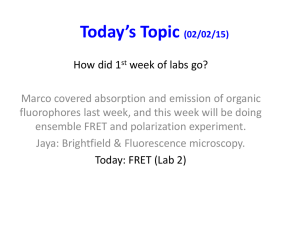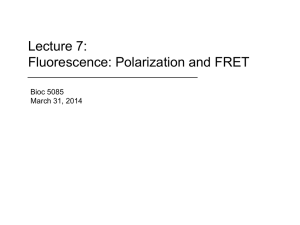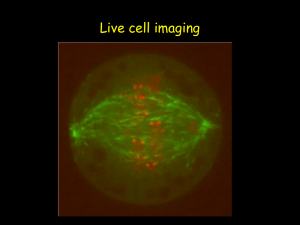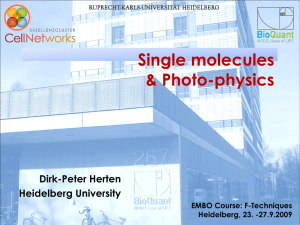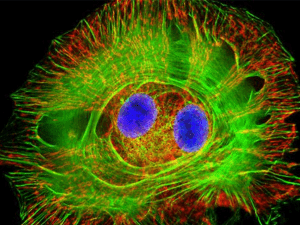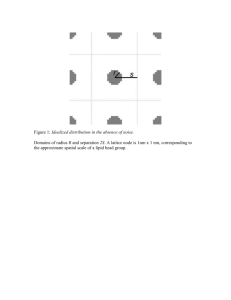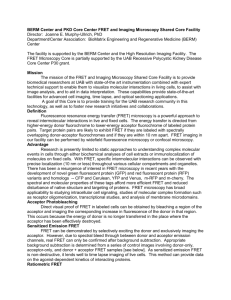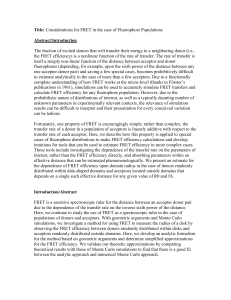looking for the inward facing state of glutamate transporters
advertisement
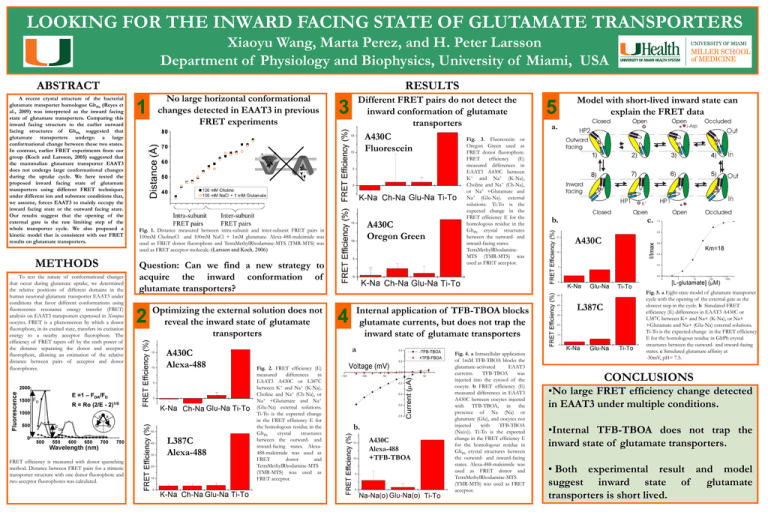
LOOKING FOR THE INWARD FACING STATE OF GLUTAMATE TRANSPORTERS Xiaoyu Wang, Marta Perez, and H. Peter Larsson Department of Physiology and Biophysics, University of Miami, USA ABSTRACT METHODS To test the nature of conformational changes that occur during glutamate uptake, we determined the relative positions of different domains in the human neuronal glutamate transporter EAAT3 under conditions that favor different conformations using fluorescence resonance energy transfer (FRET) analysis on EAAT3 transporters expressed in Xenopus oocytes. FRET is a phenomenon by which a donor fluorophore, in its excited state, transfers its excitation energy to a nearby acceptor fluorophore. The efficiency of FRET tapers off by the sixth power of the distance separating the donor and acceptor fluorophore, allowing an estimation of the relative distance between pairs of acceptor and donor fluorophores. Conductance (nS) Conductance (nS) 1 No large horizontal conformational changes detected in EAAT3 in previous 0.4 FRET experiments 0.2 0 50 1 3 0.1 0.01 1E-3 50 50 Voltage (mV) 14 10 0 50 Voltage (mV) 0 Question: Can we find a new strategy 30 to acquire the inward conformation of glutamate transporters? 2 Optimizing the external solution does not reveal the inward state of glutamate transporters A430C Alexa-488 Zd=5.9eo zd 8 Fig. 1. Distance measured between intra-subunit and inter-subunit FRET 6 pairs in 100mM CholineCl and 100mM NaCl + 1mM glutamate. Alexa-488-maleimide was 4 used as FRET donor fluorophore and TetraMethylRhodamine-MTS (TMR-MTS) was used as FRET acceptor molecule. (Larsson and Koch, 2006) 2 L387C Alexa-488 FRET efficiency is measured with donor quenching method. Distance between FRET pairs for a trimeric transporter structure with one donor fluorophore and two acceptor fluorophores was calculated. 0 Different FRET pairs do not detect the inward conformation of glutamate transporters A430C Fig. 3. Fluorescein or Zd=4.6eo Oregon Green used as Fluorescein FRET donor fluorophore. 12 G/Gmax A recent crystal structure of the bacterial glutamate transporter homologue GltPh (Reyes et al., 2009) was interpreted as the inward facing state of glutamate transporters. Comparing this inward facing structure to the earlier outward facing structures of GltPh suggested that glutamate transporters undergo a large conformational change between these two states. In contrast, earlier FRET experiments from our group (Koch and Larsson, 2005) suggested that the mammalian glutamate transporter EAAT3 does not undergo large conformational changes during the uptake cycle. We here tested the proposed inward facing state of glutamate transporters using different FRET techniques under different ion and substrate conditions that, we assume, forces EAAT3 to mainly occupy the inward facing state or the outward facing state. Our results suggest that the opening of the external gate is the rate limiting step of the whole transporter cycle. We also proposed a kinetic model that is consistent with our FRET results on glutamate transporters. RESULTS 20 4 10 A430C Oregon Green 0 Internal application of TFB-TBOA blocks glutamate currents, but does not trap the inward state of glutamate transporters a Fig. 2. FRET efficiency (E) measured differences in EAAT3 A430C or L387C between K+ and Na+ (K-Na), Choline and Na+ (Ch-Na), or Na+ +Glutamate and Na+ (Glu-Na) external solutions. Ti-To is the expected change in the FRET efficiency E for the homologous residue in the GltPh crystal structures between the outward- and inward-facing states. Alexa488-maleimide was used as FRET donor and TetraMethylRhodamine-MTS (TMR-MTS) was used as FRET acceptor. FRET efficiency (E) measured differences in EAAT3 A430C between K+ and Na+ (K-Na), Choline and Na+ (Ch-Na), or Na+ +Glutamate and Na+ (Glu-Na). external solutions. Ti-To is the expected change in the FRET efficiency E for the homologous residue in the GltPh crystal structures between the outward- and inward-facing states. TetraMethylRhodamineMTS (TMR-MTS) was used as FRET acceptor. b. A430C Alexa-488 +TFB-TBOA Fig. 4. a Intracellular application of 1mM TFB-TBOA blocks the glutamate-activated EAAT3 currents. TFB-TBOA was injected into the cytosol of the oocyte. b FRET efficiency (E) measured differences in EAAT3 A430C between oocytes injected with TFB-TBOA, in the presence of Na (Na) or glutamate (Glu), and oocytes not injected with TFB-TBOA (Na(o)). Ti-To is the expected change in the FRET efficiency E for the homologous residue in GltPh crystal structures between the outward- and inward-facing states. Alexa-488-maleimide was used as FRET donor and TetraMethylRhodamine-MTS (TMR-MTS) was used as FRET acceptor. 5 Model with short-lived inward state can explain the FRET data a. b. c. A430C L387C Fig. 5. a Eight-state model of glutamate transporter cycle with the opening of the external gate as the slowest step in the cycle. b Simulated FRET efficiency (E) differences in EAAT3 A430C or L387C between K+ and Na+ (K-Na), or Na+ +Glutamate and Na+ (Glu-Na) external solutions. Ti-To is the expected change in the FRET efficiency E for the homologous residue in GltPh crystal structures between the outward- and inward-facing states. c Simulated glutamate affinity at -30mV, pH= 7.5. CONCLUSIONS •No large FRET efficiency change detected in EAAT3 under multiple conditions. •Internal TFB-TBOA does not trap the inward state of glutamate transporters. • Both experimental result and model suggest inward state of glutamate transporters is short lived.

